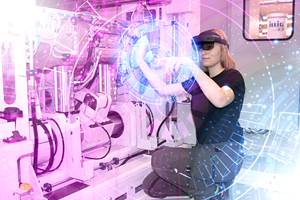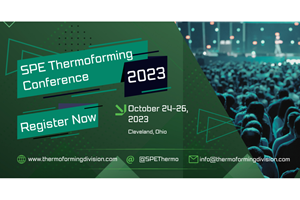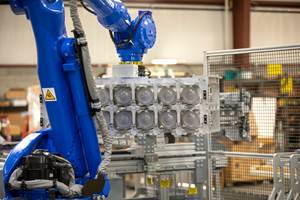Sheet Extrusion Competition Ups the Ante on Technological Sophistication
As sheet extruders consolidate, they're modernizing operations to raise output and efficiency. The pressure is on to run faster, wider, with more layers and innovative combinations of materials. The challenges multiply as sheet extrusion is teamed with in-line compounding and downstream operations like thermoforming.
Of all the areas of extrusion, sheet has been the last to catch on to many new technologies. "They tended to still use water-cooled extruders and discrete controls for each zone of a sheet line, while the trend elsewhere was toward microprocessor controls, air-cooled extruders, gravimetric feeder controls, integrated beta gauging, and general automation," says Alan Hall, sales manager for sheet at Battenfeld Gloucester Engineering. But that conservative stance is changing as processors push for higher outputs and upgrade their lines with new screw designs, higher L/Ds, more efficient cooling, and faster take-offs.
The upgrade path for some sheet extruders includes pursuit of ISO 9000 quality certification. Part of the ISO qualification program at Rampart Div. of Printpak in Williamsburg, Va., is the addition of custom computer controls to supervise materials handling. The system will monitor seven silos, 12 blenders, and 48 hoppers on three coex lines, says extrusion process engineer Gary Watts.
Consolidation of custom sheet processors is spreading the use of such "best practices" and squeezing out those who don't keep up. Spartech, the largest custom sheet extruder in North America, with 41% market share, bought out seven sheet producers in the past five years. Primex Plastics Corp., the next largest North American custom sheet producer, has also expanded rapidly, both internally and by acquisition.
Both Spartech and Primex say they focus heavily on bringing their new plants and acquisitions up to speed. Says D.J. Yoder, Spartech's v.p. of materials and technology, "In the past several years, we increased our output rates by over 300% in long sustained runs of traditional polystyrenes and ABS."
Primex, during the past two years, has established formal technical training programs conducted by professional extrusion technicians. "Process throughputs have generally increased 20% due to the employee training and upgrading of equipment at Primex," says president A.J. Lisaukas.
Sheet lines are getting both faster and larger. "A few years back, 65 or 72 in. was a wide line," notes Charles Szoke, sheet sales manager at HPM. "Now we've quoted several lines that are 120 in. wide." The widest sheet anywhere is still probably HPM's 30-ft geomembrane line at National Seal Corp., Galesburg, Ill.
A race to keep up
Meanwhile, Thomas Cleland, HPM's process manager, notes a contrary movement: "There also seems to be a trend to narrower web widths moving very fast." These widths--typically 40 to 60 in.--are determined by downstream thermoforming, laminating, or die-cutting operations that are set up in-line with sheet extrusion. Thin-gauge sheet for such operations may need to run as fast as 150 ft/min.
Such high-output systems have been one activity of the two-year-old alliance of Milacron Inc. and HPM. Last year, they shipped two lines that extrude over 4000 lb/hr for in-line thermoforming of two- and three-layer car cups.
Welex president Frank Nissel notes that such in-line combined processes are not new--some pioneering efforts go back as far as 30 years or more. The difference is that earlier attempts were not as economically competitive or repeatable. "There used to be a lot of floundering around," he says. "Now computer integration enables you to make more products, change them more effectively, and make them a half or a third less expensively."
Output rates for thermoforming in-line with sheet extrusion have risen so high that they are pushing the extruders to go faster. Nissel notes that drink cups have grown larger and forming tools now hold up to 100 cavities. "Four-layer PS drink cups have been done in-line for decades, but not 9 in. deep and not with these outputs," he says. Welex has delivered 5000-lb/hr lines for this application recently--up from 3000 lb/hr five years ago. The firm is now designing a sheet line for 7000 lb/hr to make car cups.
Compounding sheet in-line
Direct extrusion of sheet from twin-screw compounders is breaking out of exotic niche applications and into mainstream commodity products. "That's probably the only thing in sheet extrusion that is totally new in the past year," says Alan Hodge, sheet product manager at Davis-Standard, which last year delivered its first two twin-screw compounding lines for commodity sheet products.
"Historically people extruded in-line when they had no other choice," says Leistritz sales manager Charles Martin. Often the problem was heat-sensitive ingredients that couldn't take a second heat history (see PT July '98, p. 52). "Now in-line extrusion is being embraced for commodity-type products." To help customers develop new direct-extrusion applications, Leistritz recently mounted a 42-in.-wide sheet die on a 50-mm ZSE high-speed twin-screw extruder in its lab.
Filled polypropylene is one of the "commodities" that's drawing a lot of attention. Highly talc-filled PP is compounded on a twin-screw and directly extruded into a thin paper substitute. Also, heavier gauges of filled PP are being developed for thermoformed lids and containers.
Reifenhauser demonstrated in-line twin-screw compounding, extrusion, and thermoforming of PP sheet at an open house in Germany last October. Davis-Standard has tested direct extrusion of 60-70% talc-filled PP sheet. And Primex is looking at extruding PP with up to 60% of a filler combination such as calcium carbonate, magnesium carbonate, and talc.
Renaissance in coextrusion
Multi-layer rigid barrier sheet is growing again after years in the doldrums. When this market first took off in the early 1980s, making a reliable barrier layer for shelf-stable food packaging meant using costly barrier resins in heavy layers--10% of the total thickness. Today's new sheet lines run barriers as thin as 3%.
Among the sophisticated new lines installed recently is one from Battenfeld Gloucester with five extruders for nine layers. Another, described by Nissel as "the most complex we've ever built," uses six extruders to produce 11-layer sheet 40 in. wide. It makes PP/EVOH sheet for single-serve applesauce containers at Rampart.
Heavy-gauge coextrusion of industrial sheet is also on the rise, utilizing new combinations of resins and fillers or reinforcements. "Multi-layer has come a long way with intricate coextrusions," says Paul Bertsch, chairman of Primex. "New materials have come to our salvation by letting us put a thin layer on a sheet and gain properties like outdoor weatherability and gloss."
Today, Spartech produces heavy-gauge sheet with up to four layers and three materials. The company introduced 10 new coextruded sheet products in the past two years.
One example is called Endurex. It has a thin cap layer of highly filled PBT (GE Plastics' Enduran) over a core of ABS. The result is a thermoformable solid-surfacing material for uses such as vanity bowls and tops.
Another innovation is Spartech's new Formalloy HG, which marketing director Greg Nagel says is the only high-gloss TPO sheet on the market. It consists of a 0.125-0.300 in. substrate of colored TPO capped with 0.020-0.030 in. of clear, glossy PP. The gloss layer and TPO were both developed for Spartech by UVTec Inc. The company uses clarifying agents to keep crystals in the PP layer very small. "The trick was not to lose low-temperature impact strength," says UVTec plant manager George Howell.
Also new is Spartech's Marballoy PE, a marbleized polyolefin sheet for outdoor playground products. It creates a repeatable stone appearance by means of three extruders running different colors of the same PE resin. The three melt streams come together in distinct layers until they are mixed in swirls just before the die.
Another unusual new coextrusion from Spartech is its Millennium III structural sheet, which combines a 20-30% glass-reinforced polycarbonate core with two unfilled PC skin layers. The result is high stiffness--2.5 times that of ABS--with a smooth surface. (The skin layers also protect the die from abrasion by the glass.) Said to be the only glass-filled PC sheet on the market, it also offers a coefficient of thermal expansion only half as great as that of ABS. One application is thermoformed body panels for a fire engine.
Skin-foam-skin coextrusions are another promising sheet application. Spartech is developing a thermoformable three-layer coextrusion with a foamed PE core. Battenfeld Gloucester is testing a new foam-skin line for food packaging that uses an annular die to extrude a large horizontal tube. The company's previous foam-skin sheet lines used flat dies.
More novel materials
New materials are also proving to be a key to competitiveness in monolayer sheet. For example, metallocene polyolefin elastomer (POE) is one new resin that's beginning to appear in sheet products. S&L Plastics Inc. in Nazareth, Pa., recently started extruding and in-line die cutting POE sheet for an automotive product on a new 6-in. Davis-Standard extruder with a special screw design. "We're the first in the country running this material from silos," says S&L president John Bungert. He explains that POE requires specially shaped silos and internal agitators to keep the sticky pellets flowing through the surge bin and the gravimetric blender on the extruder.
Because POEs have relatively low melting points and this is a fairly thick sheet, S&L's new line requires extra cooling. It has a bank of four air-cooling chambers that sit over and under the sheet and are fed chilled air. This is the most elaborate cooling installation Davis-Standard has made since introducing its intensive air-cooling system last year.
Another unusual sheet product that also relies on special cooling technology is a foamed HDPE sheet produced by Wabash National Co., Lafayette, Ind. Introduced last year, the sheet is used for 53-ft-long sidewalls on Wabash's semi-truck trailers. An HPM line extrudes the foam at 4800 lb/hr with a 50% density reduction. Since foam is hard to cool, the Wabash line has six large chill rolls--three of 30-in. diam. and three of 36 in. "That may be a record," says Bill Calland, Wabash's plastic processing manager.
A new type of monolayer packaging sheet that protects sensitive electronics from electrostatic discharge was introduced last September by Hyperion Catalysis. Its reportedly unique characteristic is higher conductivity on one side of the sheet than the other. The sheet gets its properties from small amounts (less than 5%) of Hyperion's patented carbon fibrils, which are hollow tubes a mere 8 nanometers in diameter--a thousand times thinner than conventional carbon fibers.
The trick is to concentrate more fibers on one side of the sheet than the other. The resulting difference in conductivity makes the inner surface of the sheet facing the electronics semi-conductive, while the outside is highly conductive. "So if someone builds up a static charge and touches the package, the charge stays on the outside," says Hyperion general manager Stephen Friend. PT
New Developments in Dies & Deckles
One of the next advances in sheet dies will be self-adjusting automatic die control, which until now has been used only on thin film up to 0.125 in. thick, says John Ulcej, v.p. of technology for Extrusion Dies Inc. (EDI). "In the future a scanner will measure sheet thickness and adjust a membrane die the same way our Autoflex die works on film," he says. "Automating the membrane will increase the range that the Autoflex system will handle."
An exciting development in this direction is the use of a servo motor to automate sheet dies. Putting a servo drive on a dual flex-lip die permits motorized lip-gap adjustment to a range of 0.200 in. The first known example is being installed this month on a QuickGap die from Cloeren Inc.'s Production Components Div. The die is used on a pilot line for an equipment supplier.
Cloeren may also apply a servo drive to its recently developed Power Wedge Deckle. This deckle now is operated manually with a wrench to adjust die width by up to 30 in. on each side "on the fly." It is used for up to 2-in.-thick sheet of thermally stable resins. On the market for a year, Power Wedge has suddenly attracted a surge of interest, says Douglas Darrow, corporate v.p. of sales. "We have put 25 in production, all in the last six months," he notes.
In recent months, Cloeren has applied a new curved pre-land to its Epoch II coat-hanger die for monolayer and coex sheet. Such a feature has been used to promote uniform layer distribution in cast film but is new for sheet, Darrow says.
Related Content
Enhanced Digitization in Thermoforming
Illig’s Easy product family includes the newly developed Human Machine Interface, Illig Easy Touch.
Read MoreClock's Ticking: Register Now for 2023 SPE Thermoforming Conference
Three-day event kicks off Oct. 24 in Cleveland.
Read MoreUS Merchants Makes its Mark in Injection Molding
In less than a decade in injection molding, US Merchants has acquired hundreds of machines spread across facilities in California, Texas, Virginia and Arizona, with even more growth coming.
Read MoreAn Automation 'First' for Non-Servo-Eject Trim Presses
Compact, flexible and configurable robotic system is said to be the first to enable thermoformers to fully automate product handling after a non-servo trim press.
Read MoreRead Next
Advanced Recycling: Beyond Pyrolysis
Consumer-product brand owners increasingly see advanced chemical recycling as a necessary complement to mechanical recycling if they are to meet ambitious goals for a circular economy in the next decade. Dozens of technology providers are developing new technologies to overcome the limitations of existing pyrolysis methods and to commercialize various alternative approaches to chemical recycling of plastics.
Read MoreWhy (and What) You Need to Dry
Other than polyolefins, almost every other polymer exhibits some level of polarity and therefore can absorb a certain amount of moisture from the atmosphere. Here’s a look at some of these materials, and what needs to be done to dry them.
Read More



























.png;maxWidth=970;quality=90)